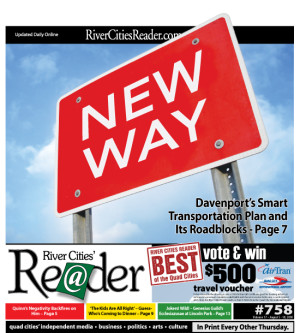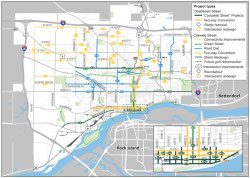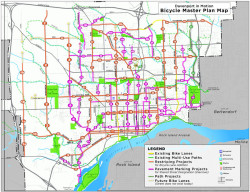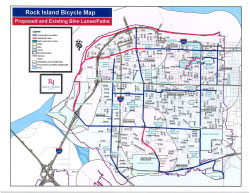 In an interview promoting his 2007 lecture at the Figge Art Museum, urban planner Jeff Speck promised that his ideas would be "controversial." He explained to me that "most cities, for better or for worse, are being designed by their public-works departments, who state as the highest objective the free flow of automobiles."
In an interview promoting his 2007 lecture at the Figge Art Museum, urban planner Jeff Speck promised that his ideas would be "controversial." He explained to me that "most cities, for better or for worse, are being designed by their public-works departments, who state as the highest objective the free flow of automobiles."
Three years later, the City of Davenport is on the cusp of approving a 10-year comprehensive transportation plan called "Davenport in Motion" that draws from the philosophy Speck promotes. The shock is that it's barely controversial at all.
Highlights include returning Third, Fourth, Brady, and Harrison streets to two-way automobile traffic, adding bike lanes and other pavement markings to create a citywide network of cyclist-friendly routes, altering roadways "to ensure safe vehicle travel speeds and mobility for all travel modes" (including foot traffic), and optimizing the downtown-parking situation. It also addresses two areas this article won't: restructuring CitiBus to achieve "significant improvements in efficiency and service quality (frequency and hours of service)," and a plan for northwest Davenport.
Davenport in Motion is more than 900 pages long (costing the city $330,110), but its overarching goal can be boiled down to this bit from its introduction: "a transportation system that is multi-modal, interconnected, and supportive of a pedestrian-friendly urban community where residents can access daily needs and activities by foot, bike, or transit." (Download links for the plan can be found at RCReader.com/y/motion. To read an article previewing Speck's 2007 speech, go to RCReader.com/y/speck.)
Davenport in Motion is no panacea, and there are roadblocks. The plan doesn't include an overall price tag, and it of course still needs to be implemented. The downtown-parking element remains problematic, as Davenport's surfeit of parking makes it difficult to encourage through scarcity modes of transportation beyond the automobile. Because Brady and Harrison are part of U.S. 61, changing them to two-way streets would require approval beyond the city council. And transportation is just one element of urban planning.
But the plan is tangible evidence that Davenport has taken Speck's criticism to heart. The free flow of automobiles is no longer Davenport's primary transportation objective.
In the Mainstream
It's worth noting that the substance of Davenport in Motion isn't a surprise, given whom the city selected to write it: the transportation planners of Nelson\Nygaard Consulting Associates, which specializes in the sort of sustainable development that Speck preaches. (Speck's company also contributed to the plan.)
But Dan McNeil, a member of the Quad Cities Transportation Alternatives Group, said he was "pleasantly surprised" that Nelson\Nygaard was chosen in the first place, and "that the [city] council has been so supportive."
After Speck spoke in the Quad Cities, McNeil said, it was reasonable to ask what would come of it. McNeil credits Davenport City Designer Darrin Nordahl for advocating a modern approach to transportation planning. "They're very lucky to have a progressive thinker in that position," he said.
"We really wanted a multi-modal plan -- so a plan that doesn't just address automobile traffic ... ," Nordahl said last week. "We really wanted an element that addressed our transit system, biking as transportation, as well as walking as transportation. And also parking. We know that you can't give people an abundance of free parking and expect them to ride the bus or walk or bike."
Davenport in Motion doesn't make the city cutting-edge, but it certainly puts it ahead of the other Quad Cities. Thomas Brennan, a principal with Nelson\Nygaard and project manager for the Davenport in Motion consultant team, said that if the plan were implemented today, "you'd probably be on the leading edge in terms of cities your size. But given what we're seeing around the country, as the plan gets implemented over time, you're more likely to be in the mainstream."
"We know that this is the way communities are going to be designed," McNeil said. "So cities have a choice: to be on the front end in planning -- Davenport is -- or be behind."
Nordahl said he expects that the council will approve the plan as a whole, perhaps with some adjustments on the issues of downtown parking and converting one-way streets to two-ways. He said he's hoping for passage by the end of August, but that depends on how quickly Nelson\Nygaard can incorporate feedback from public meetings that were held through August 2.
Just as McNeil was "pleasantly surprised" by the consultant choice and the council reception, Brennan said Nelson\Nygaard was "pleasantly surprised by the appetite of the city for change" -- including citizens, staff, and the city council. "It's often staff that does the hiring," Brennan said, and it's not terribly uncommon that once you start working with the community, there's a decent amount of resistance to a different model, or a different approach."
 Adopting the transportation plan is just the first step. While Davenport in Motion outlines and prioritizes projects for 10 years, council action will still be required on individual projects. The city expects that some projects can be funded through grants, and others can be integrated into normal road maintenance. The remainder will likely be part of the city's capital-improvement budget.
Adopting the transportation plan is just the first step. While Davenport in Motion outlines and prioritizes projects for 10 years, council action will still be required on individual projects. The city expects that some projects can be funded through grants, and others can be integrated into normal road maintenance. The remainder will likely be part of the city's capital-improvement budget.
On the funding question, Brennan said Nelson\Nygaard "didn't even try to put together a total plan cost."
There are several reasons for this. For one thing, material costs are changing rapidly.
More importantly, he said, "a lot of the types of projects that we're recommending that promote mode shifts are actually long-term cost-saving measures. The most expensive thing the city could do is continue to grow its land development like it has the last 20 years." The suburban model is expensive in terms of infrastructure and services, he said, and its sprawl "essentially guarantees that you won't be able to utilize much more cost-effective means of transportation -- like transit, like cycling, like walking ... ."
That speaks to a larger issue: Fundamentally, Davenport can't change itself without also addressing its development patterns. "You can't divorce land-use planning from transportation planning," Nordahl said. "They're inextricably linked. ... That is part of a much, much larger policy discussion. ...
"The land-use patterns have to change. ... As long as we continue to develop greenfield sites at very, very low densities, far from where the jobs and the core of goods and services and our universities are, then it's going to be tough to see any measurable gain. That's not just for Davenport. That's city-building in general. We have to figure out how we can encourage developers to invest in the central city and along those streets where we tend to have high transit use. ...
"That's going to be difficult," he said, and will require willpower from the public and the city council.
Simple Modifications
 Implementing much of Davenport in Motion, though, is relatively easy, involving little more than paint.
Implementing much of Davenport in Motion, though, is relatively easy, involving little more than paint.
"We have within our power [the ability] to make some simple modifications to our streets and hopefully see some great improvements in the way people choose to move around," Nordahl said. "The majority of the recommendations that they have here involves re-striping."
"A lot of what we're recommending are projects on streets that will need to be rebuilt anyways," Brennan said. "You're just spending differently."
Nordahl said it hasn't been decided whether re-striping would happen as its own capital project, or on a street-by-street basis during normal road maintenance.
In nearly all cases, re-striping will involve adding bike lanes. The city already added bike lanes on Jersey Ridge Road and Marquette Street, and those provide examples of the city's new bicycle-friendly approach.
"People do want to bike," Nordahl said. "We can encourage people to start using alternate modes of transit if we at least provide safe, comfortable facilities for them. ... We have a long way to go on providing those safe and comfortable facilities."
Looking at all the re-striping projects in the transportation plan, it becomes clear that Davenport in Motion aims to create a relatively dense network of clearly marked bicycle routes.
 It's instructive to compare the plan's bicycle elements to Rock Island's 2009 Bikeways Plan. Rock Island's plan outlines projects that would essentially create four east-west bicycle routes and four north-south ones. Basically, it's an arterial system; you'll be able to get around Rock Island by bike, but you'll likely need to go significantly out of your way. Davenport's plan would create more of a web, making travel more direct, quicker, and safer.
It's instructive to compare the plan's bicycle elements to Rock Island's 2009 Bikeways Plan. Rock Island's plan outlines projects that would essentially create four east-west bicycle routes and four north-south ones. Basically, it's an arterial system; you'll be able to get around Rock Island by bike, but you'll likely need to go significantly out of your way. Davenport's plan would create more of a web, making travel more direct, quicker, and safer.
In some cases in Davenport, streets would merely have bike lanes added. In other situations, though, the bike lanes would be added as part of "road diets" or "complete streets" -- which involve altering traffic in addition to painting bike lanes.
Road diets, Brennan said, are correctives to streets designed to handle more traffic than they're actually carrying. Economic retraction in recent decades, he said, has resulted in "significantly overbuilt streets that are singular in their purpose and have become a detraction to safe pedestrian travel downtown and some of your core neighborhoods like the Hilltop, as well as a challenge for retail, street-front-level local business."
Road diets typically convert streets from four lanes of automobile traffic to three -- including a center turn lane -- and add bicycle lanes.
For example, downtown streets are 55 feet wide curb-to-curb, Nordahl said. So the plan recommends reconfiguring most downtown streets for one travel lane in each direction and a turn lane (each 10 feet wide), five-foot-wide bicycle lanes on each side, and 7.5-foot-wide parking lanes on each side.
This configuration would make bicyclists feel safe on city streets -- both because of dedicated bike lanes and because of slower traffic. "Narrowing traffic lanes certainly helps," Nordahl explained. "Introducing elements of surprise, like if you see a lot of people on the street ... , that helps slow traffic down. The presence of bicyclists tends to slow traffic down," as do street trees and parked cars.
All of those things would bring downtown streets close to being "complete streets," which Nordahl explained have four components: a balance of pedestrians, bikes, and motorists; safety; comfort; and interesting things to look at.
And the combination of slowing traffic down and introducing more bicycle and foot traffic is arguably good for businesses. Drivers and car passengers will see more storefront businesses, and bikers and pedestrians will, too. And that effect would be multiplied on Third, Fourth, Harrison, and Brady streets with two-way traffic.
Congestion Concern
There's a cost to all of that, though: Slower traffic can lead to congestion.
"A lot of cities around the country are accepting very high levels of congestion in downtowns and retail streets because they're realizing that very slow traffic is a benefit to businesses," Brennan said.
Congestion, Nordahl said, is the primary objection he has heard to making Harrison and Brady two-way streets. But it's also a concern wherever road diets are proposed.
But Nordahl said that slower-moving traffic doesn't necessarily mean a longer travel time; because following distances between vehicles are less at decreased speeds, a "slower" road might actually move more cars.
Still, he said, "there is a perception that if they [Harrison and Brady] go back to two-way, it will take as long as 15 minutes to get from Locust Street to the downtown." Some congestion is anticipated on Locust Street and Central Park Avenue, he said, but "people's perception that it's going to triple or quadruple the [travel] time ... is unfounded. ... There might be some delay, but it's probably going to be measured in seconds and not minutes."
Almost by definition, though, the type of transportation system outlined in Davenport in Motion requires slower-moving cars, which will sometimes translate into longer travel times. "What they're asking is: How much congestion can you live with?" Nordahl said.
Even if it makes some trips five minutes longer, McNeil argued, the benefits of this holistic approach to transportation are worth the cost: "To have a better community, I think it's worth an extra five minutes."
Beyond the congestion and speed issues inherent in converting one-way streets to two-ways, the Third, Fourth, Brady, and Harrison projects are more costly than most roadway modifications recommended in Davenport in Motion.
Nordahl estimated that adding the necessary signals to Third and Fourth streets -- which is suggested as a first-year Davenport in Motion project -- would cost between $1.2 million and $1.5 million. Re-signaling the Brady/Harrison corridor -- slated for year two or three -- would cost a similar amount, he said.
Concern about Brady and Harrison congestion makes that project more difficult than most of the other recommendations -- and not just at the council and community levels.
And here you can see the tension between traditional car-moving transportation planning and this new way. Additional congestion on Brady and Harrison might be good for the community -- "because it means there's lots of other sorts of traffic, [and] businesses get better visibility ... ," Nordahl said -- but the Iowa Department of Transportation could nix it. "They're extremely skeptical that reverting to two-way is good," he said, because it's looking at a different set of criteria: uncongested automobile traffic versus a roadway system geared toward business visibility, bicyclists, and pedestrians.
The Parking Catch-22
At least the state could theoretically be convinced to support the conversion of Brady and Harrison to two-way streets. Davenport's downtown-parking situation is a problem because there might be no solution that meets everybody's goals. The city wants parking-meter revenue to help pay off parking-ramp debt, but Nelson\Nygaard believes that in Davenport's situation, free parking is better for downtown.
Nordahl isn't sold on no-cost street parking. "Getting people on the street, just to create a sense of vitality -- that has appeal to me," he said. But he's not sure that free parking will lead to more people downtown. "I think we need to actually provide stuff for people to come downtown," he said. "I think the cost of parking plays a role. ... I'm not sure what the answer is."
According to Davenport in Motion, the city has 4,446 downtown parking spaces -- 1,675 of them on the street. It found weekday peak-demand usage in July 2009 of 33 percent -- 28 percent on the street and 36 percent in lots and the city's three garages.
Davenport in Motion suggests an optimal on-street-parking usage of 85 percent on each block -- giving the appearance of downtown health while still making parking convenient. To that end, Davenport late last year began bagging its downtown meters and offering free parking as a pilot project.
This was called a "right-pricing" strategy, with the idea of finding meter rates that would achieve optimal on-street usage. The plan was to start with free parking, identify contiguous blocks of high usage, and return those areas to metered parking. But the vast amount of parking in downtown Davenport meant that the right price was nothing throughout downtown. "You keep lowering your price until you get high utilization, but since we do have so much parking, utilization never meets that minimum criterion," Nordahl said. "So we don't charge for it."
Davenport in Motion recommends replacing or reducing the size of surface parking lots to drive on-street and ramp demand, but "we don't have the ability to [significantly] restrict parking even if we wanted to, because we have too much of it," Nordahl said. "Downtown parking, we're stuck with what we got. ... The consultants said that we probably should have rethought building those [two] ramps [that opened in 2003]. At the time, there was likely already too much parking."
Free street parking affects city coffers in three ways: It reduces meter revenue, it reduces revenue from fines, and it drives down usage of city-owned parking ramps. And those ramps are dependent on parking revenue of all sorts for their debt service.
According to Davenport Finance Director Alan Guard, ramp utilization including RiverCenter event parking and hourly meters at the other two ramps is presently about 41 percent. To meet parking-revenue projections, "the overall utilization of the ramps ... probably needs to be in the 75-percent range, in addition to some level of revenue for on-street parking ... ," he wrote in an e-mail. " Offering free two-hour parking is like cutting off one leg of a three-legged stool. The stool will fall over." Guard said parking revenue has dropped at an annualized rate of $360,000 since free downtown parking was instituted.
At that rate, Guard said, the city's Parking Fund would be wiped out in two years covering the ramp-debt-service shortfall. That has led some aldermen to suggest uncovering downtown's parking meters purely to boost parking revenue.
That's counter to the Nelson\Nygaard recommendations, but this is one example of what might happen when the progressive, noble ideals of Davenport in Motion meet budget and political realities. As Nordahl said, "It is a money issue."








